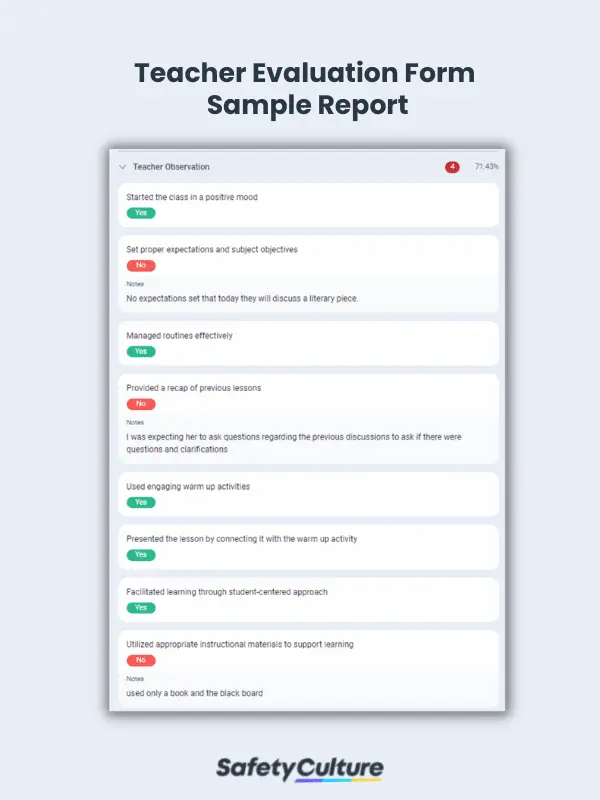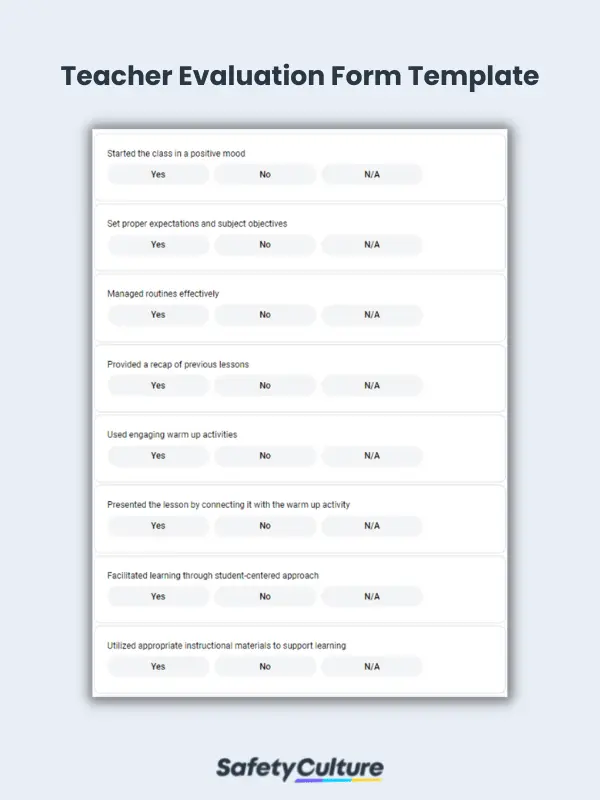What are Teacher Evaluation Forms?
Teacher evaluation forms can be used by trained evaluators or school administrators when performing classroom observations. These forms can help improve teaching practices by evaluating how the teacher engages the students and how they create a conducive learning environment. Teacher observation forms can also be used to document performance for annual evaluation and accreditation.
What is the Purpose of a Teacher Evaluation?
A teacher evaluation is often conducted school-wide by administrators and principals to allow fellow teachers, students, parents, stakeholders, and other related parties to provide feedback on teachers’ conduct based on their observations and experiences. The findings from observing a teacher and evaluating them will then be used to determine and improve the quality of teaching and learning, either on an individual level or a school-wide level.
Some aspects of teaching that are considered during a teacher evaluation are:
- The teacher’s teaching style
- The goals set for students
- The teacher’s flexibility to accommodate different learning styles
- The average class size
- The student attendance and discipline rate
- The relationship between teachers, students, and their parents
What Should Teacher Evaluation Forms Include?

Teacher Evaluation Form Sample Report | SafetyCulture
To make the process of evaluating teachers easier, teacher evaluators use teacher evaluation forms to streamline it. The format of teacher evaluation forms varies per school, but generally, they will have sections for:
- The department where the teacher belongs to
- The class and subject being evaluated
- The date of evaluation
- The way the teacher starts and ends the class
- The way that the teacher engages with the students
Some teacher evaluation forms also prompt evaluators to conduct an interview with the teacher. While not necessary for all cases, conducting an interview can help the evaluator make a more informed decision and provide better feedback. Evaluators often ask questions about:
- How successful they believe their teaching was
- What they think about their own performance
- How do they measure the success of their teaching styles
- What evidence do they have of their students learning from their teachings
- If they think they followed their lesson and teaching plans or not
- What they would do differently
At the end of the teacher evaluation forms, the evaluator should then give their recommendations before submitting them to the school administrators or principal for review. To ensure the validity and authenticity of the evaluation, teacher evaluation forms should also contain the signature and name of the evaluator. With a digital form, this becomes easier to do and manage.
Using digital teacher evaluation forms also allows schools, evaluators, and teachers to:
- Spend fewer resources on managing paper trails for past evaluations
- Access their forms from any internet-powered device
- Save changes to their answers or overall forms easily
- Recognize points for improvement
FAQs about Teacher Evaluation Forms
A quick checklist-type teacher evaluation form can take only a few minutes to complete. However, for a more comprehensive evaluation, it would be best to accomplish teacher evaluation forms for the duration of a whole class.
You can evaluate teacher effectiveness for evaluations by considering the following:
- Criteria for evaluation: the criteria agreed upon by the school administration that create an effective teaching method
- Evidence: any past or present documentation of how effective a teacher’s teaching style is in the classroom
- Standards: the internal set of standards in a school on what counts as high-quality teaching
Most teacher evaluations are held once a year randomly. Annual evaluations are the most common kind of teacher evaluations, as they can help teachers improve throughout the year, or for the next year. However, some schools do it every semester instead.


